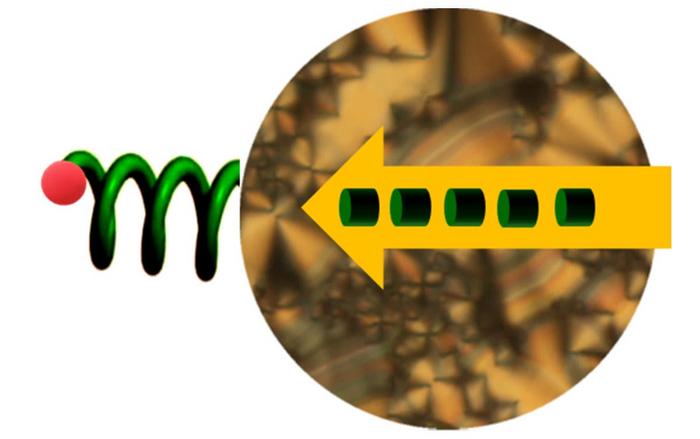
Researchers at the University of Tsukuba, Japan, have made a groundbreaking advancement in the field of polymer chemistry. They developed a novel method for synthesizing optically active helical polymers known as polyisocyanides. This remarkable achievement lies in their ability to manipulate the helical structures of these polymers through the utilization of a liquid crystal reaction environment. The controlled chirality of these structures allows for significant applications in optics, particularly in fields requiring materials with specific circular dichroism properties.
In essence, polyisocyanides are unique among polymers due to their inherent helical structures. This structural characteristic provides the foundation for the polymers’ optical abilities, notably circular dichroism and optical rotation. Circular dichroism is a phenomenon wherein different wavelengths of light are absorbed to varying extents depending on the molecular configuration. The researchers successfully demonstrated that the chirality of the resultant polymers could be controlled simply by adjusting the reaction conditions and the type of catalysts used, representing a remarkable leap forward in polymer synthesis techniques.
Traditionally, the synthesis of chiral polymers has involved complex chemical processes which often yield low degrees of optical activity. The innovative work from the research team represents a substantial conceptual shift, leaning towards physical methods for synthesizing these exciting materials. They exploited the unique properties of liquid crystals, which can serve as reactive solvents, creating an environment conducive to reaction conditions that favor the growth of chiral polymers. This alignment in the liquid crystalline phase enables a more efficient and effective polymerization process, which is both reliable and reproducible.
The research team detailed their methodology, highlighting the significance of the liquid crystal’s structure in reaction conditions. They utilized liquid crystals exhibiting chiral (mirror-image isomers) structures, a critical selection that ultimately affected the helical outcome of the synthesized polymers. The team successfully demonstrated that when achiral monomers were placed in this chiral liquid crystal reaction field, asymmetric, or chiral, living polymerization could be achieved for the first time. This pivotal discovery opens the door to a new class of materials that can be used in a variety of applications in optics and beyond.
The results of their studies confirmed that the resulting polyisocyanides exhibited distinct optical activity, verified through circular dichroism measurements. These findings suggest that the helical formations of these polymers are not merely theoretical but can indeed be synthesized and observed in practical applications. With the identification of the twisted-bend nematic phase present within the liquid crystal, this research not only elucidates aspects of chiral polymer synthesis but also offers valuable insight into liquid crystal behavior—an area that continues to capture attention within the scientific community.
The biomimetic nature of their approach—drawing parallels between the polymerization process and enzymatic growth of amino acids in biological systems—illuminates the potential implications for the design and synthesis of new materials that can replicate biological functions. This method allows for the creation of polymers that mimic the essential qualities of proteins, particularly those with helical structures. As the demand for advanced materials continues to grow, such biomimetic technologies hold significant promise for future applications in various fields, including medicine, materials science, and engineering.
Such innovations signify more than just a technical advancement; they provide a fresh perspective on the critical interplay between structure and function within polymer chemistry. The targeted synthesis of optically active materials can significantly contribute to the fields of photonics and optoelectronics, where the demand for materials that can manipulate light efficiently is ever-increasing. Integrating these newly developed polymers into existing technologies could foster advancements in data transmission, display technologies, and even optical sensors.
It is imperative to acknowledge that while the discoveries made hinge on the control of chirality and polymer structure, the implications extend far beyond mere academic interest. The researchers envision future applications where these insights may lead to the introduction of novel optical devices that leverage the unique properties of these chiral polyisocyanides. As industries continue to seek sustainable and efficient materials, understanding the syntheses processes and their outcomes can catalyze the development of next-generation technologies.
The collaborative nature of this project underscores the importance of interdisciplinary research in driving scientific progress. The engagement of various fields—including chemistry, physics, materials science, and biology—highlights the integrative spirit necessary to tackle complex scientific challenges. By bridging gaps between these disciplines, researchers can share insights and techniques, ultimately propelling innovation in the synthesis and application of advanced materials.
As we move forward, it will be essential to build upon this foundation. Researchers will undoubtedly need to explore the scalability of this synthesis method for industrial applications. Investigating the reaction conditions further will ensure that the production of chiral polyisocyanides can be achieved in a cost-effective and high-yield manner. Such efforts will be crucial in transforming laboratory-scale advancements into practical applications that can revolutionize the materials used in modern technology.
In conclusion, the work stemming from the University of Tsukuba represents an extraordinary leap in polymer science. As the researchers forge ahead in their explorations, the scientific community eagerly anticipates further developments that will arise from this pioneering research. With practical applications on the horizon, the implications for technology and industry are boundless, leaving ample room for further exploration and innovation in the fascinating and ever-evolving world of polymer chemistry.
Subject of Research: Synthesis of optically active helical polymers
Article Title: Asymmetric Synthesis of Chiral Polyisocyanides from Achiral Monomers with Living Polymerization in Liquid Crystal Reaction Field
News Publication Date: 2-Jan-2025
Web References: link
References: Macromolecules (ACS)
Image Credits: University of Tsukuba
Keywords
Polymers, Liquid crystals, Chirality, Chemical reactivity, Block copolymers, Self assembly
Tags: asymmetric living polymerizationcatalysts in polymer synthesischiral polymer synthesis techniquescircular dichroism applicationscontrolled chirality in polymershelical structure manipulationliquid crystal reaction environmentsoptical properties of polymersoptically active helical polymerspolyisocyanides synthesispolymer chemistry advancementspolymer optical activity enhancement





